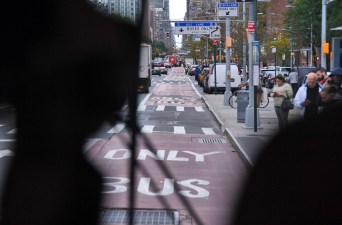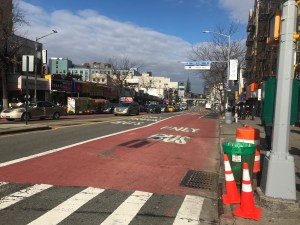Buses Work Best on Car-Free Streets, MTA Data Shows

City & State NY is hosting a full day New York in Transit summit on Jan. 30 at the Museum of Jewish Heritage. This summit will bring together experts to assess the current state of New York’s transportation systems, break down recent legislative actions, and look towards the future of all things coming and going in New York. Join Keynote Speaker Polly Trottenberg, commissioner of the NYC Department of Transportation, along with agency leaders, elected officials, and advocates. Use the code STREETSBLOG for a 25-percent discount when you RSVP here!
MTA officials said on Monday that bus lane cameras are speeding up snail-like service along congested corridors, but in the same announcement, the agency ended up emphasizing a strategy that works best, yet is so rarely instituted: getting cars out of the way of buses entirely.
In a new analysis issued on Martin Luther King Jr. Day, the MTA said that its enforcement cameras on just three Select Bus Service routes — the M15 and M14 in Manhattan and the B44 between Williamsburg and Sheepshead Bay in Brooklyn — have issued 9,110 tickets or warnings to drivers blocking bus lanes between Oct. 7 and Dec. 31.
Bus travel speeds are up on all three camera-enforced lines — but they are up dramatically along only one route: the car-free 14th Street busway, which didn’t even get camera enforcement until late November.
The data:
- The busy M15 route along the East Side of Manhattan, where 6,910 tickets and warnings have been issued since Oct. 7, December bus speeds were 1.5 percent better than they were during the same month of 2018. Real tickets began being issued on Dec. 6.
- The busy B44 route, where 2.090 tickets and warnings have been issued since Oct. 30, bus speeds in December were 2.8 percent faster than the same month of 2018. Real tickets began being issued on Dec. 29.
- But, wow, bus speeds along the car-free portion of the 14th Street busway are up 55 percent — even though cameras have only issued 110 warnings since Nov. 21. Actual tickets will start being issued on Tuesday, Jan. 21.
And ridership along the M14 is up 19 percent on weekdays and up to 25 percent during the morning rush hour, the agency said, without providing an update on ridership along the other two camera-enforced routes.
Given all of the statistics released on Monday, it’s clear that cameras don’t do nearly as much to increase bus speeds or improve ridership as getting rid of cars. The MTA has praised the city’s pilot busway program on 14th Street, but the MTA has yet to demand specific car-free bus priority routes going forward, leaving it to the city to plot out its next moves. Mayor de Blasio has said more car-free busways will be revealed during this calendar year.
The topic came up on Friday when MTA bus officials briefed reporters on the preliminary draft of the agency’s Queens bus network redesign, which has been hailed by many experts, but criticized for local cutbacks in service in some neighborhoods, including Jackson Heights.
NYC Transit Senior Vice President Craig Cipriano told reporters that the 14th Street busway represented the “vision” for the agency.
“We have $85 million in next capital plan for cameras,” he said. “So that once we have the cameras, it’s not a manual process to enforce that, and our buses will be moving along. If you look at 14th Street today, the busway, that would be our vision for the bus system across the five boroughs.”
Streetsblog asked Cipriano what he meant by “vision” because it was unclear if he was also seeking more car-free busways.
“Our vision … would be to have well-enforced bus priority, camera-enforced bus lanes, all door boarding … and transit signal priority,” he said.
Streetsblog still didn’t hear the magic words, so we persisted: “What about more routes without cars?”
Cipriano’s answer was telling: “One thing about getting rid of cars … we know we need to peacefully co-exist with other transportation modes, whether it’s pedestrians, cyclists or cars,” he said. “But we need our due: we need well-enforced bus priority.”
The agency has highlighted 21 “bus priority corridors” that will favor buses over cars, though apparently not banish automobiles entirely. Until that day, cameras will play their limited role in speeding buses. By the end of 2021, the MTA said cameras would be deployed on 1,000 buses across the five boroughs.
But there remains something odd about the MTA’s belief that cameras are the key to speeding up buses. In November, the agency put out a statement timed to the beginning of camera-issued warnings on 14th Street — where bus speeds had already improved 38 percent, largely by the elimination of cars along the corridor. The agency seemed reluctant to mention the car ban as the most important factor.
“Our bus-mounted cameras will heighten enforcement of new NYC DOT’s Transit Priority lanes that have completely transformed 14th Street from being one of the most congested corridors just a few months ago,” Cipriano said at the time. “The added layer of enforcement reinforces the importance of bus lanes to improving our service: when bus lanes are clear, everyone moves faster.”
And one thing is clear: bus lanes are clearest when there are no cars to block them.




